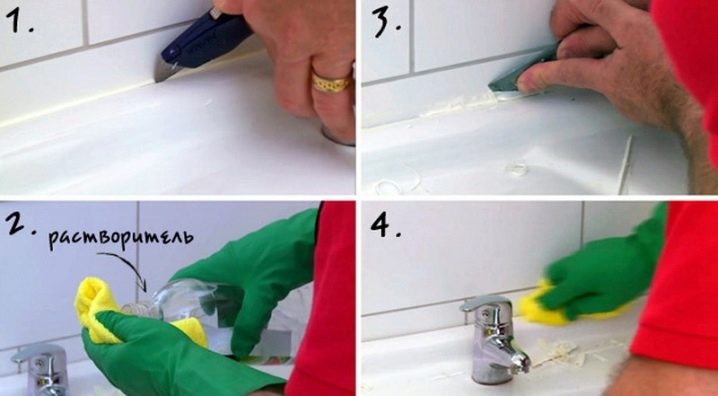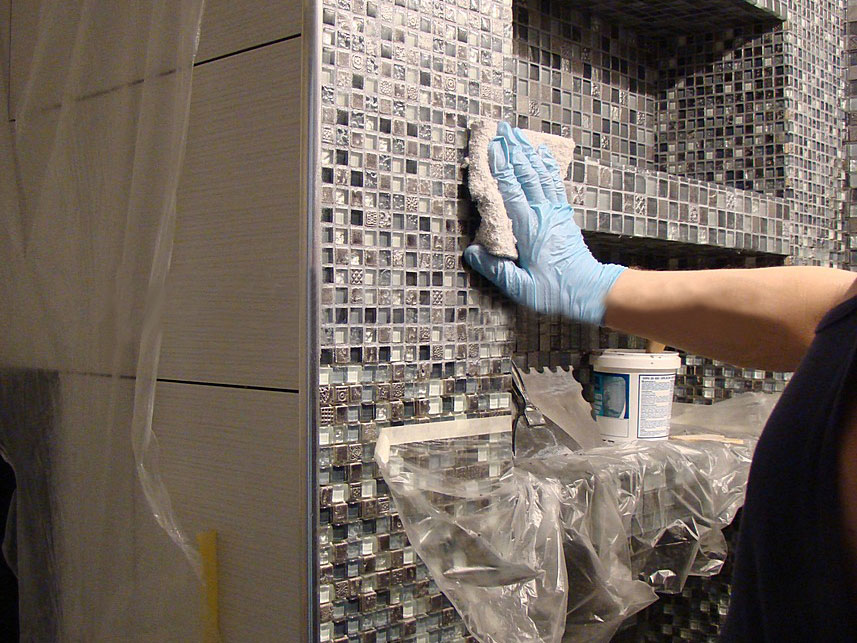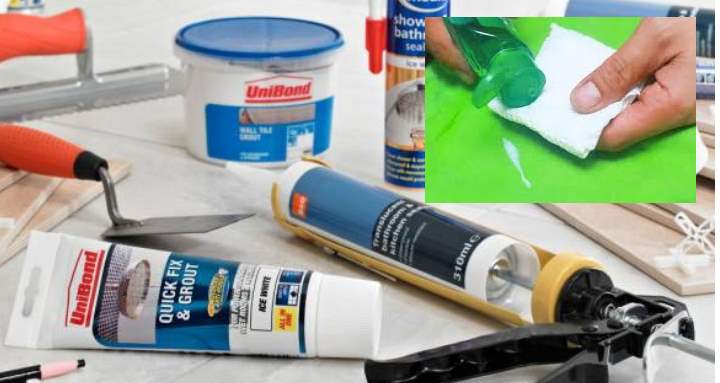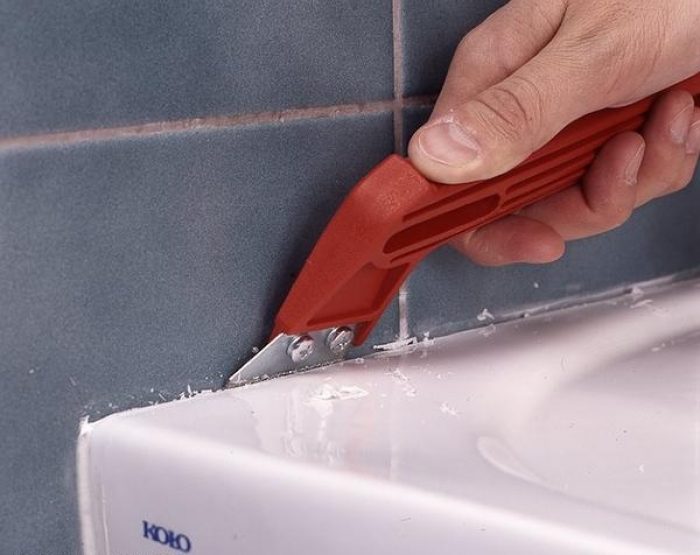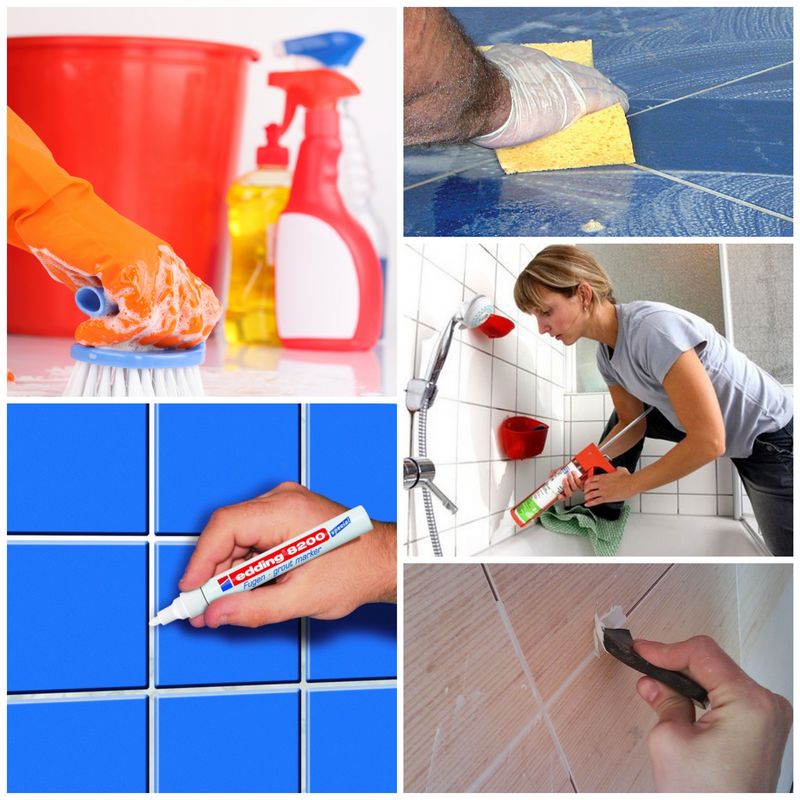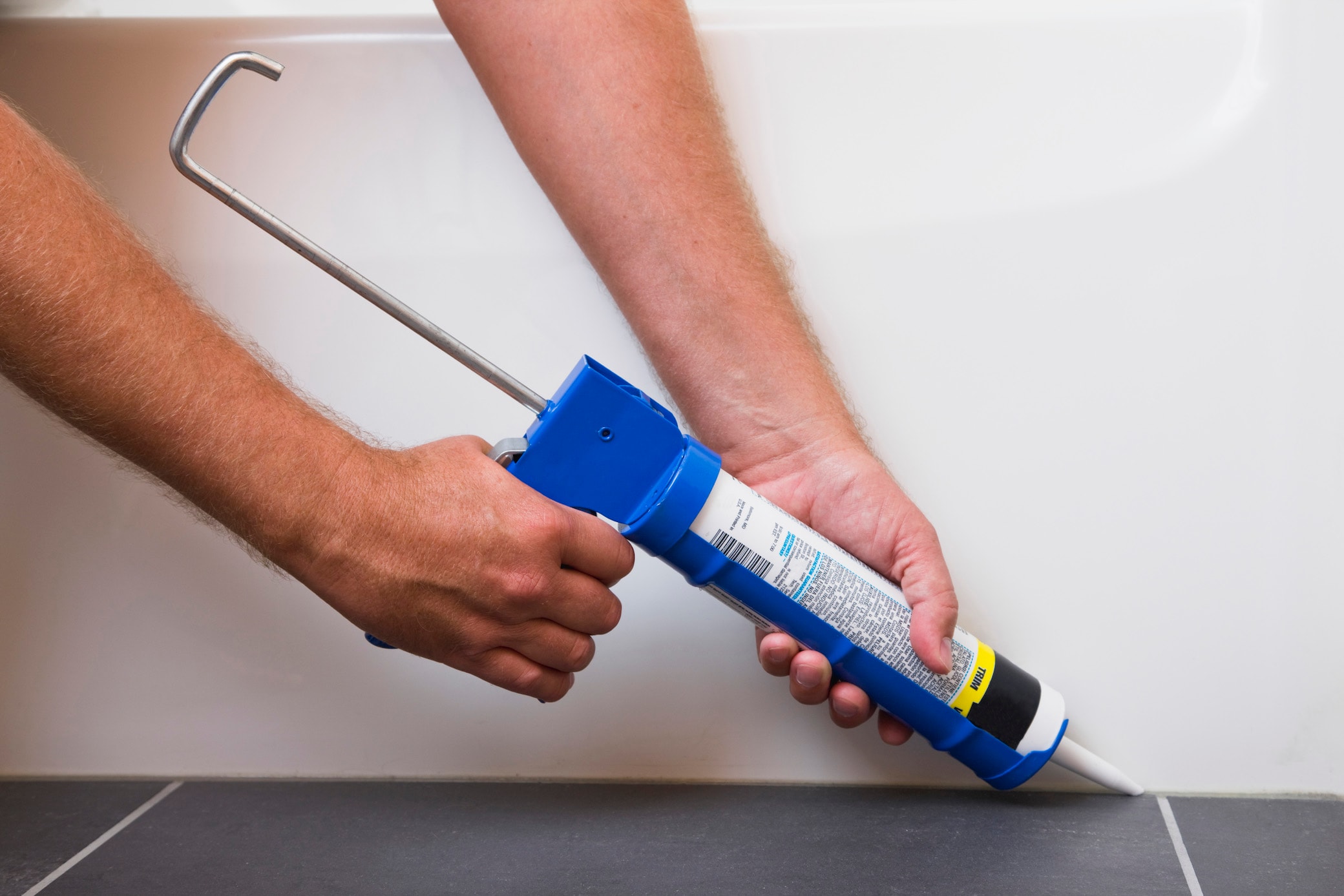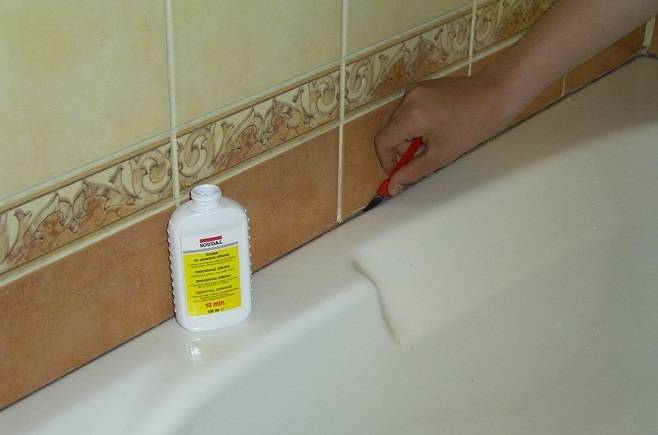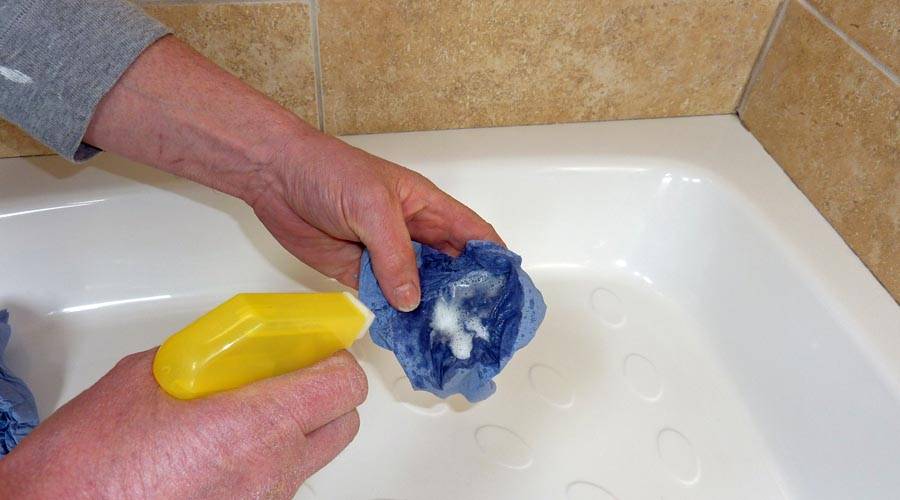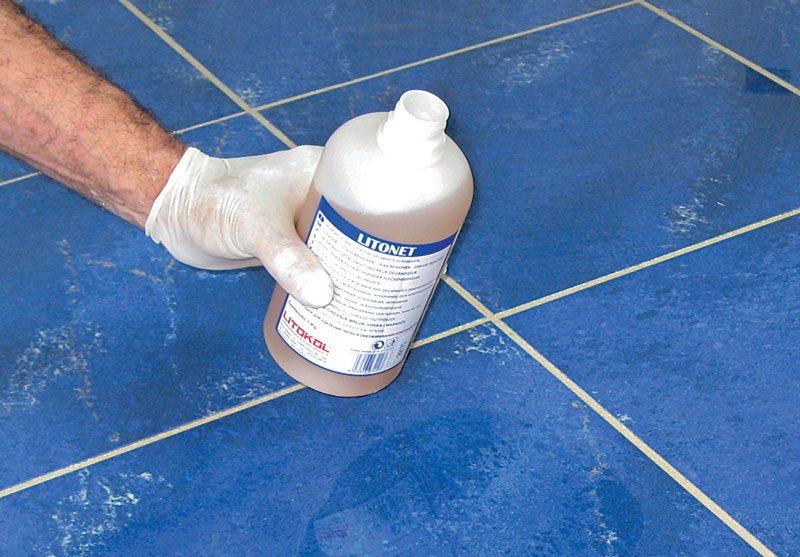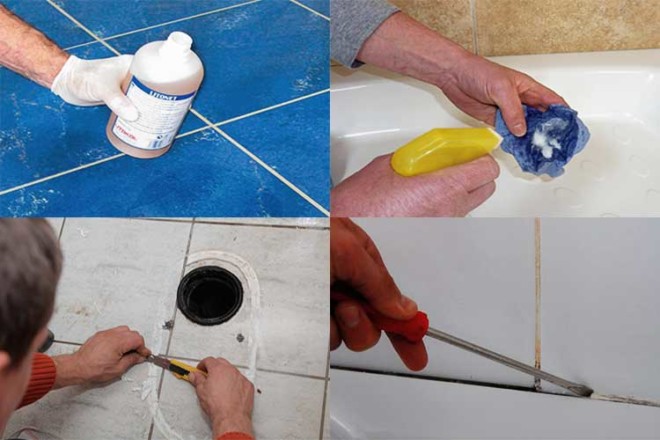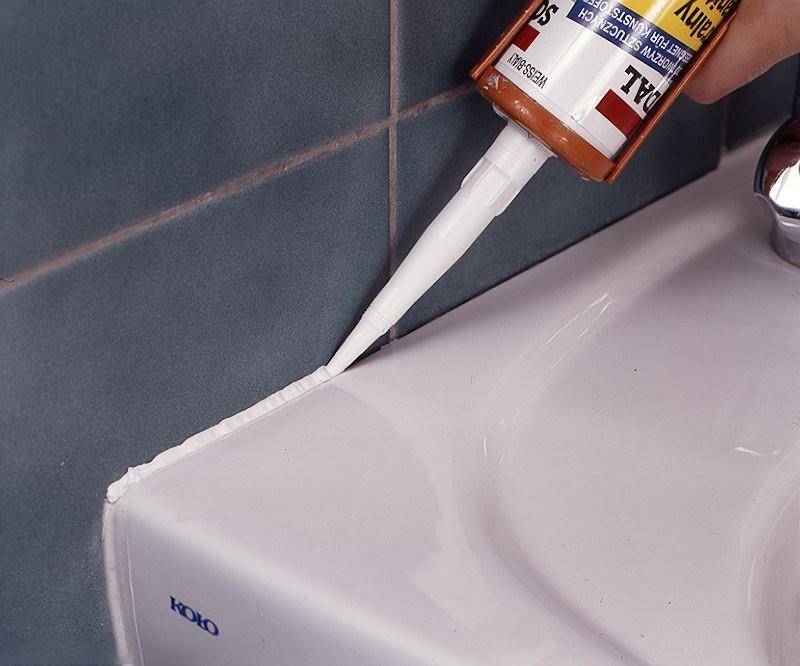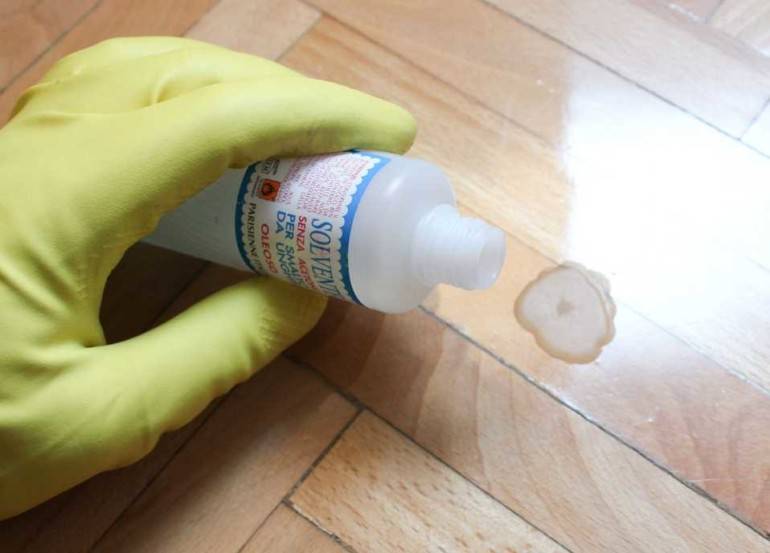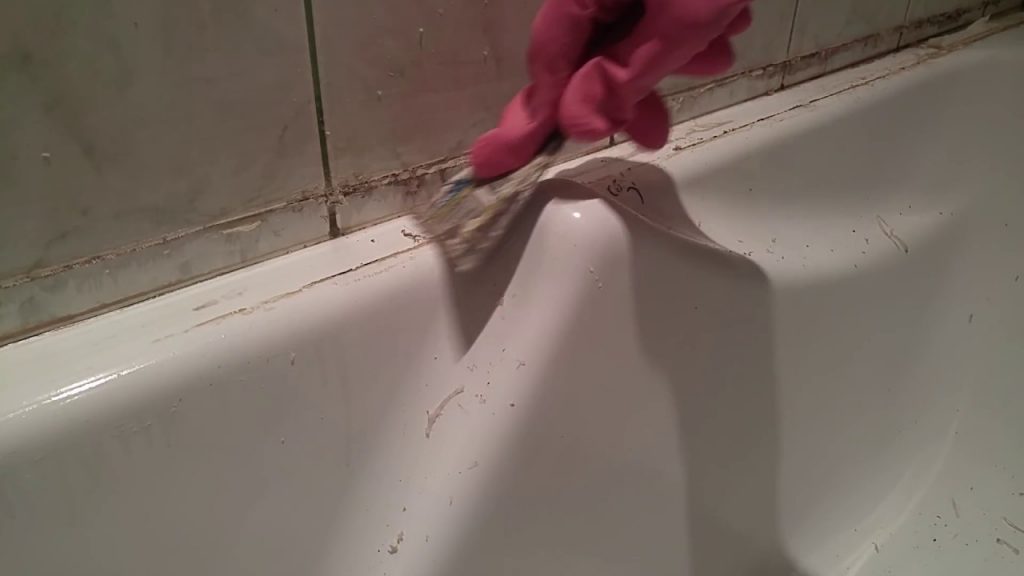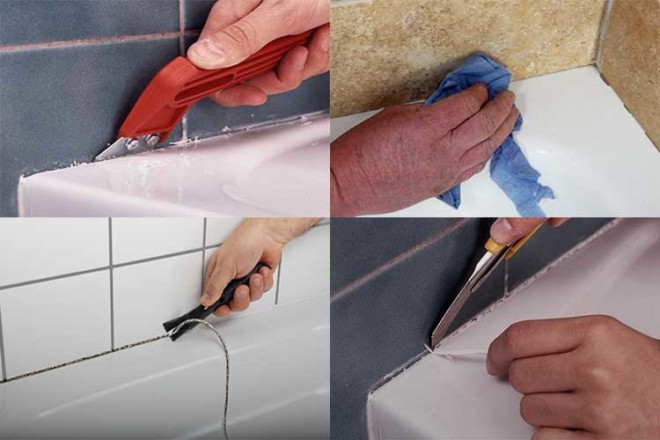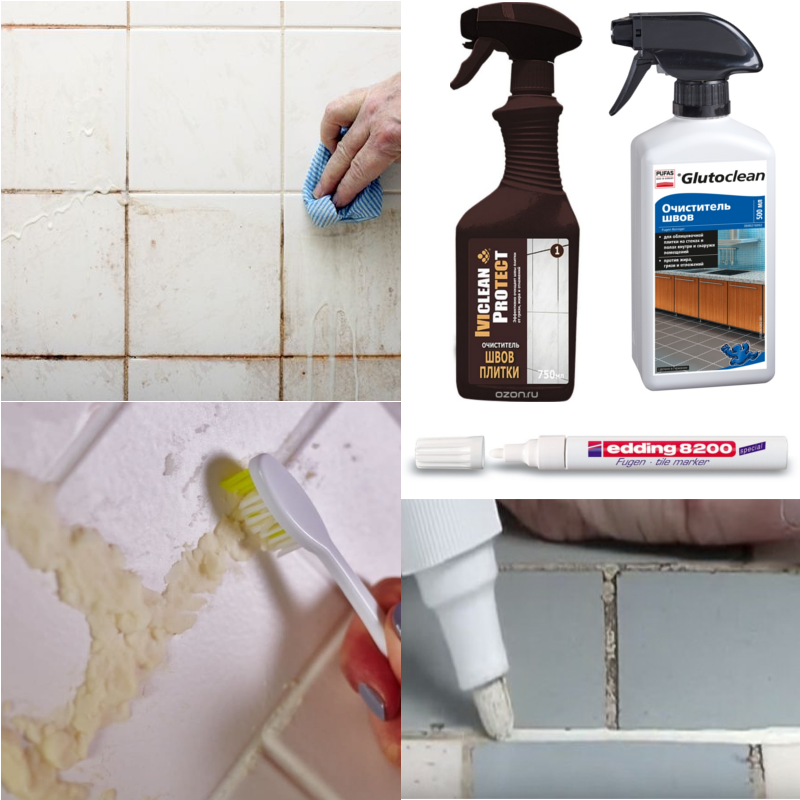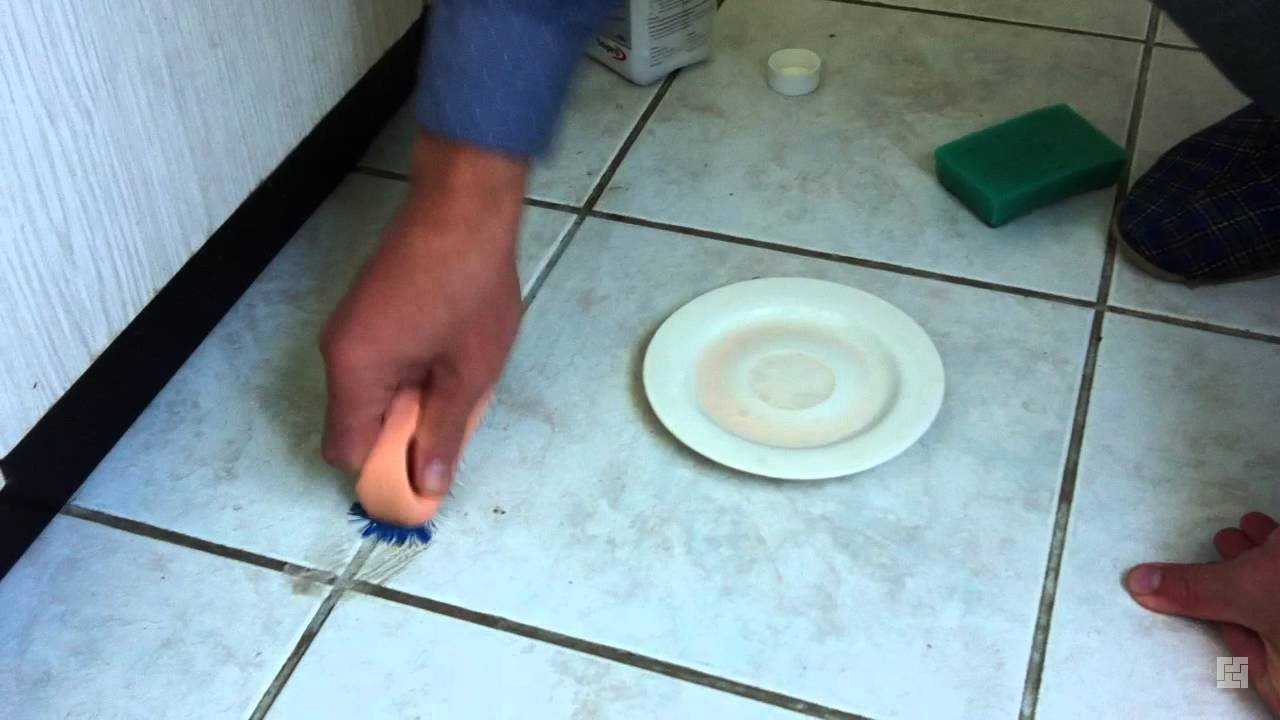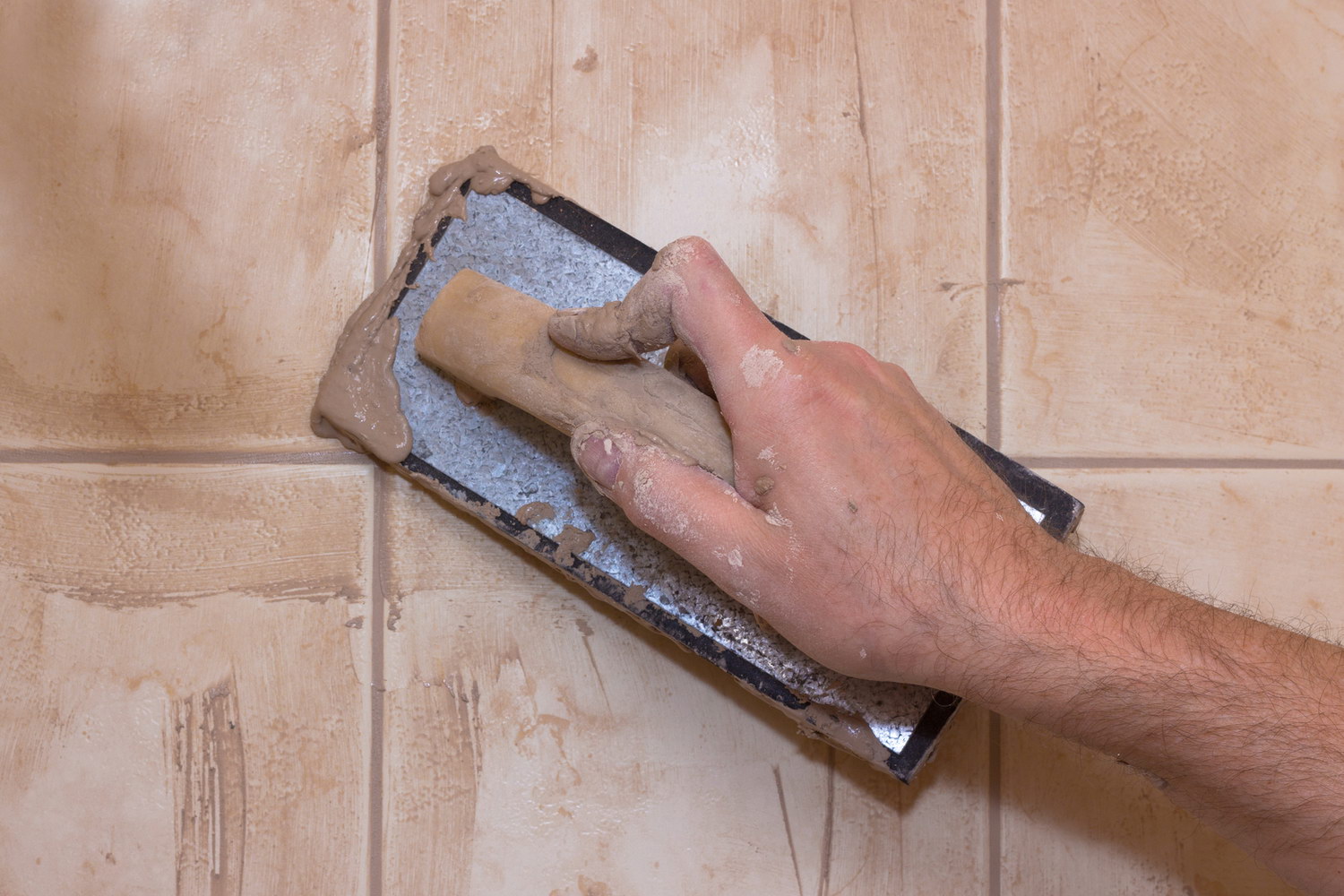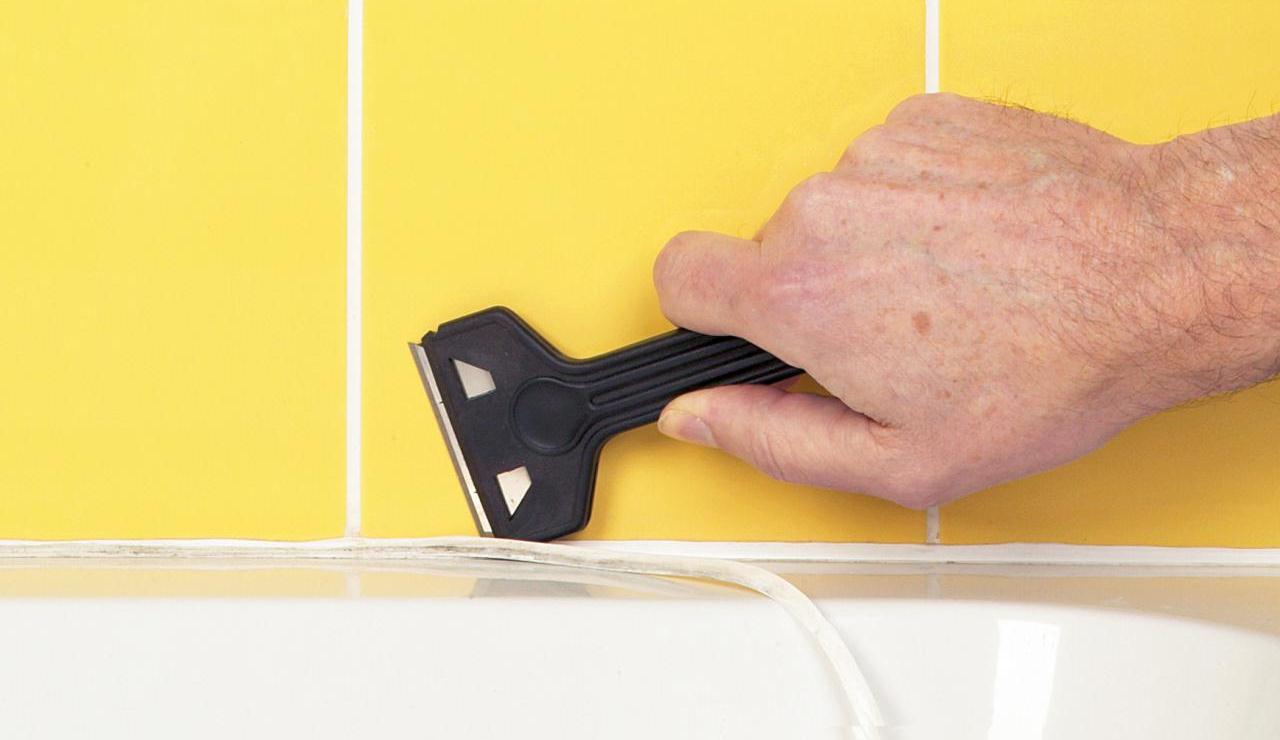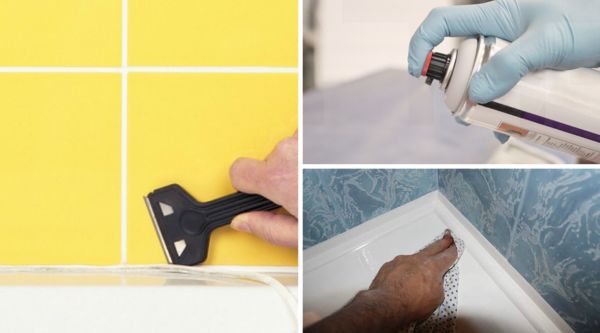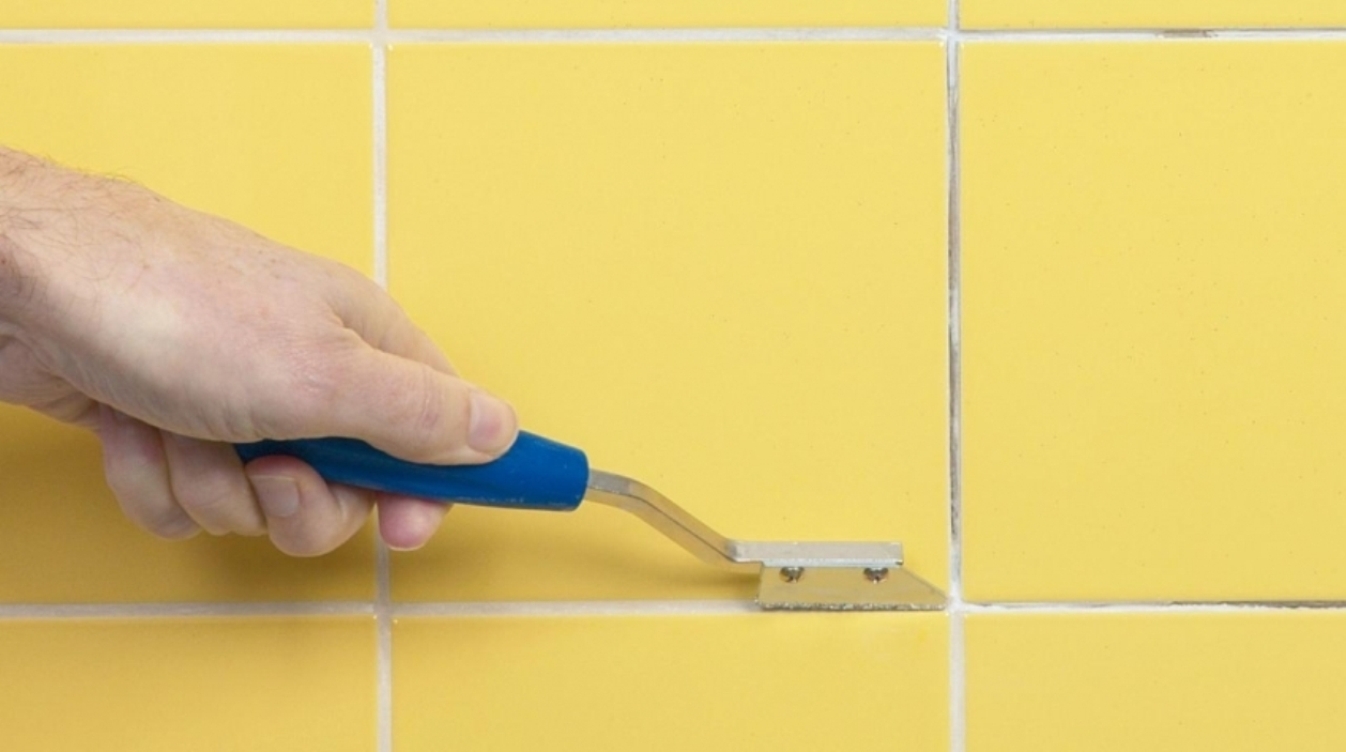Removing acrylic sealant
Acrylic sealants can be water-borne and waterproof. But their main function is not sealing, but gluing. Interior compounds are porous and generally water-soluble. Therefore, in the bathroom, their use is limited to places where water does not get into (you can glue various hooks, mirrors or shelves).
Waterproof acrylic sealants are designed for exterior decoration and construction work. In general, they are universal and, after complete drying, are not afraid of moisture, but constant contact with water has a bad effect on their properties. Borders (or plinths) for bathtubs and washbasins are sometimes installed on waterproof acrylic glue, which is not entirely correct.
Removing acrylic sealant is much easier than silicone sealant:
- excess fresh glue can be easily wiped off with a sponge or cloth moistened with water;
- the old dried composition is cut out with a clerical knife or blade;
- water-soluble acrylic is moistened with water until softened;
- from the edges of the acrylic bath, waterproof acrylic sealant can be removed with polyurethane foam, acetone, nail polish remover or a solvent such as White Spirit;
- the remains of the composition are removed with a wooden scraper or plastic window cleaner;
- acrylic sealants, after removal, do not leave greasy marks and stains, so additional treatment with solvents is not required.
- The sealant has not been correctly applied, which does not provide protection against moisture penetration. Then the inaccurately applied layer is removed, the seam is filled with sealant again.
- Over time, the sealing layer wears out and deteriorates, it can change its color due to burnout or heavy contamination. The seam may crack, which will significantly impair its moisture-protective characteristics. The deteriorated layer must be removed immediately.
- Even if antiseptic additives are included in the sealant, during prolonged use in conditions of high humidity, for example, in a bathroom, microorganisms can multiply on the surface, which is why mold quickly appears. The contaminated layer must be removed as soon as possible, since mold growing in dampness can worsen the well-being of apartment residents.
- During repairs, sealant accidentally spills onto unsuitable surfaces.
- The fresh layer is easily removed with a washcloth or a cloth soaked in water.
- Old marks are first trimmed with a knife or razor blade.
- If the dried mixture dissolves in water, the residues are softened and removed with a damp cloth.
- You can remove waterproof waterproofing from the edges of an acrylic bathtub with construction foam, acetone, white spirit and other similar solvents.
- The remaining traces are removed with a wooden scraper.
- After acrylic mixtures, no greasy stains remain, therefore additional solvent treatment is not necessary.
Acrylic sealants are both water-soluble and moisture-resistant. These compounds are not used for sealing, but for gluing. After solidification, they form a porous structure.
How and how to wipe off the sealant
Immediately after application, the substance is difficult to see on the surface, but after a few hours it turns from transparent to white. It becomes clear on which surfaces you need to remove splashes, stains or align seams and joints.
Instruments
- Construction trowel. The wide handle makes it easy to use for removing even heavily dried sealant.The edge of the tool must be intact, and if there is a chipping, it is useless and even dangerous to use it, there is a possibility of damage to the surface.
- Construction scraper. Helps to quickly remove glue residues and not destroy tiles.
- Razor blade. For the most inaccessible places, small dirt is quickly erased. Due to its small size, the blade is not always convenient to use; if you handle it carelessly, you can cut your hands.
- Boot knife. Helps to peel off very thin layers of adhesive.
- Screwdriver. The sealant is removed in hard-to-reach areas. In order not to damage the tile, you need to work without strong pressure.
- Tongs, tweezers, pliers. The tools can grab loose parts of the sealant if it cannot be done with your fingers.
Special tool. They represent a handle with replaceable attachments of various shapes. Nozzles are selected for any angle and type of surface. It can remove both old waterproofing and seal joints with a new mixture.
Cleaning procedure
- First, remove the top layer of silicone with a knife or blade. For this, a longitudinal and transverse section is made between the treated base and the adjacent seam layer. Slightly hardened waterproofing is sheared off in one longest possible longitudinal movement.
- If it was not possible to completely remove the silicone from one time, it is necessary to grasp the incised edge with your fingers and separate all the pieces one by one.
- Residues are removed with a spatula or scraper tool.
For acrylic surfaces, it is best to use wooden trowels.
- Old waterproofing is removed from crevices and cracks with plucked tools.
- It is difficult to cut off a thin waterproofing layer; it is usually wiped off with sandpaper, pumice stone or a metal washcloth for cleaning dishes.
- To clean the embossed surface without damaging it, a school eraser or pumice stone is used.
- When dismantling an acrylic bathtub or shower tray, the outer seam is first cut around the entire perimeter of the bowl. Then it is pushed on with a screwdriver and loosened slightly. If it does not immediately pry off, the influx is continued to be cut with a knife until the bowl is detached from the base.
Removal of non-difficult contaminants
In the presence of severe dirt and such that are not even stained, but lumps, a spatula will do. It is necessary to remove the nodules, carefully prying each one. The main thing is not to rush and perform all movements at a smooth pace, otherwise you may not calculate your efforts and leave scratches on the tiles, which will be very unpleasant. This technique is suitable for removing solutions mixed with water.

The situation is different with polyurethane compounds. Cleansing also involves gently prying off, but then a little light pulling and lifting from the surface. Not a single cleaner at this stage will cope with the task, since it makes no sense to dissolve abundant influxes.
But grout may not present clots on the tiled surface, but only drops or stains. They can also be cleaned mechanically.
Before you clean the grout from the tiles, you need to prepare:
- container with warm water;
- clean rags;
- gloves;
- putty knife.
Wielding a spatula, they try to crush the entire structure of the spots. After that, a piece of cloth is soaked and, wiping the stains in a circular motion, they begin to fight against simple contamination on the tile. You can also use cloths soaked in the product to clean small stains.
Typically, cleaning tiles with embossed surfaces involves the use of special solvents and acids. However, the inconvenience is that the composition is clogged between the porous tile structure. You can walk on a matte surface with a brush or a sponge. But it is not recommended to do this with glaze.
Stores have a special grout remover. Moreover, the range of such products is quite wide.These are potent solutions for different types of textures and surfaces, based on alkali or acid (or both together). Each such product has an action interval strictly defined by the manufacturer, which can neither be underestimated nor exceeded by applying the drug to the tiled layer of dirt.
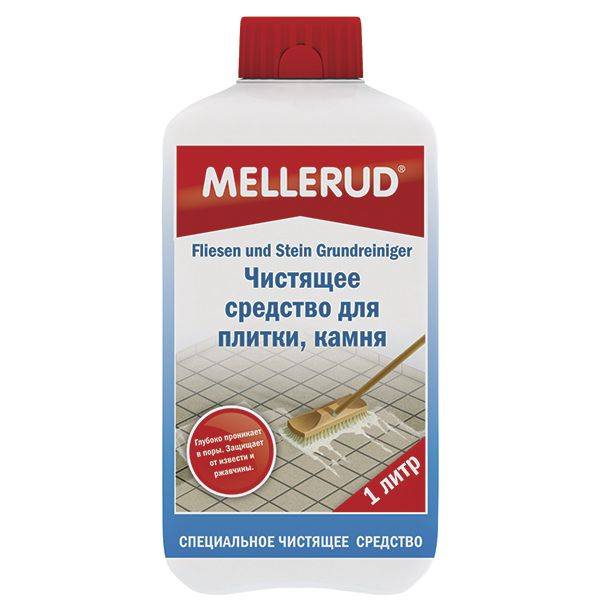
Basically, the products of the chemical industry are used when it is not possible to mechanically wipe off the grout from the tile with the corrugated side. To apply the composition, use sponge or brush... The product is applied pointwise. With a large area of contamination, work is carried out in an accessible area, limited to the processing of two square meters. Gradually covering the rest of the zones. It is easier to work with small areas, if only because a so-rubbed area of dirt at the very beginning will not have time to dry out while working with stains throughout the territory. After applying the product to the traces of the trowel mixture, you do not need to wait more than the time indicated by the manufacturer of the product. Otherwise, it will be problematic to wash the tiles after the repair.
Cleaning methods
Only fresh, not yet cured silicone is removed quickly and without consequences. Therefore, if during application the product gets outside the working area (on tiles, bathtubs, sinks, floors or clothes), it should be quickly wiped off with a sponge or rag.
Fungus on silicone is the most common reason why it needs to be removed.
If you plan to reapply the sealant, the work surface should be especially carefully cleaned of the old layer. There is practically no adhesion between the molecules of fresh and polymerized silicone. Therefore, if the old layer is poorly removed, poor sealing is likely.
To clean the surface of dried sealant, mechanical and chemical agents are combined. In any case, physical effort is indispensable, so they start working with the mechanical method. At the same time, they try to gradually remove the thickest layer of silicone, since chemistry is able to dissolve only a relatively small layer.
Mechanical method
To work you will need the following tools:
- a sharp clerical or construction knife (you can purchase a special knife for expanding silicone seams);
- blade;
- small spatula;
- tweezers;
- flat screwdriver;
- special plastic or wooden scrapers to remove sealant;
- pumice.
Stages of work:
- Preliminarily thin layers of silicone are cut with a knife or blade. For this, longitudinal and transverse cuts are made between the surfaces and the adjacent sealant layer. If the silicone is not hard enough, you can try to remove it in one motion. For this, the longitudinal cuts are made solid and as long as possible.
- Grip the cut edges with tweezers or fingers and separate strips and pieces of old silicone.
- With a spatula or special scrapers (wooden ones are preferred for acrylic surfaces), remove residues.
Cleaning off silicone residues with a glass scraper.
- If somewhere the silicone gets into cracks or cracks, it is pryed off and pulled out with tweezers, small pliers or forceps.
- The thin layer of remaining sealant is very difficult to remove, but you can try doing it with fine sandpaper, the hard side of a dish sponge, or a pumice stone.
- To remove the sealant from the tile, you can rub it with a stationery eraser or pumice stone. The eraser is especially helpful when you need to clean the embossed tile and not damage it.
- At least one person is required to remove tubs and shower trays. Dismantling begins with cutting off the outer layer of silicone around the entire perimeter. Then they pry the tub or pallet with a screwdriver and try to loosen it. If the product gives in, it is lifted and transported to a prepared place. Otherwise, the seal continues to be cut with a knife or blade until it is possible to detach the bath.
Chemical methods
Since it is almost impossible to completely remove the old sealant in the bathroom using the previous method, mechanical cleaning is often complemented by chemical treatment.
This is interesting: Metal siding - characteristics, advantages and installation
How to dissolve silicone sealant: the basics of work
Household chemicals
The easiest way to remove silicone from clothing is to remove it immediately after being soiled. The uncured mixture is quickly removed from the fabric, the remains are wiped off with a rag, and, if necessary, the thing is washed. If the product has dried up, the actions are as follows:
- the thing is laid out on a flat surface, the dirty area is straightened;
- with a thin tool, pry off the dried substance and remove it from the material;
- the stain remaining on the clothes is rubbed with a sponge dipped in vinegar or alcohol;
- after a while, the stain is again moistened with a solvent and cleaned with an old toothbrush, the pellets that appear are removed by hand;
- the applied chemistry with silicone is washed off with a warm soapy solution.
From organic products, you can use sunflower oil. The oil itself does not cleanse well, so it is warmed up a little in a saucepan and washing powder is added. After using the product, hands are thoroughly washed with running water and soap.
Vinegar diluted in water, in a 1: 1 ratio, copes effectively with silicone. After removal, hands are washed with warm water and laundry soap.
If the silicone has not yet hardened, pick it up with a hard object and scrape it off. If the stain is dry, soak the area of clothing in vinegar for 10-15 minutes, and then remove with a cloth.
Method 2 - pour alcohol on the dirty place and start brushing with a toothbrush. The silicone will begin to roll off and you can easily remove it.
You can simply lather your hands with laundry soap and rub with a pumice stone. Several such procedures may be required.
According to construction statistics, in 50 percent of cases, special glue falls into the hands of the one who applies it. Excessive haste, neglect of skin protection - the reasons are different, but the outcome is the same: a mixture on the palms. How to clean the silicone sealant from your hands so that the epidermis stays in place? Obviously, caustic household chemicals are not appropriate here. Folk advice on how to wipe silicone sealant off your palms recommends the following:
- take 9% vinegar and mix with water in a 1: 1 ratio. Soak a cotton swab or cotton pad in the resulting solution and wipe your skin. Do not rub too hard to avoid damaging the dermis layer;
- A high-quality nail polish remover will help wash the silicone sealant. You can put it on a cotton swab and apply it to the place where the composition got. 2-3 minutes is enough to remove the mixture;
- clean the silicone sealant from your hands as follows: pour into a deep bowl or bowl of warm water, add 3 tablespoons of sea or table salt, immerse in the palm solution for 10-15 minutes. After the procedure, the special glue will soften and can be easily removed with running water and soap;

- how to wipe off the silicone sealant if it just got on the dermis? A plastic bag! Take the bag and apply it to the skin. The mixture will stick to the polyethylene and fall behind the palms;
- alcohol tonics for oily skin are also able to fight back with special glue. Apply the solution to a cotton swab and apply for 5-10 minutes;
- Gasoline or acetone will help wash the glue. Every motorist has these funds. A couple of drops are enough. Apply gasoline or acetone to your skin, the mixture will come off;
- before starting work, smear your palms with fat cream or any oil. It will not be very convenient to work, but the glue will not stick to the dermis.
So simply and quickly you can dissolve silicate without the use of special chemicals.
After removing the substance from the skin, treat the epidermis with a regenerating cream such as Bepantant or Triderm to avoid irritation.
If there is a reaction in the form of a rash or tumor, take an antihistamine medicine (medicine for allergies - "Zirtek", "Suprastin").
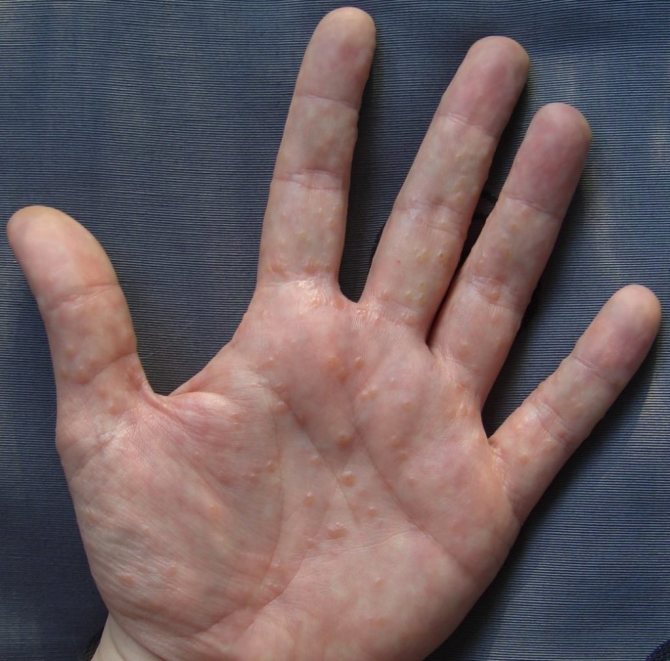
When working with the composition, clothes are often dirty. It can be cleaned of silicone sealant in the following ways:
- remove the item, place it in a plastic bag and send it to the freezer for 3-5 hours. After the thing is removed, the composition can be removed by hand;
- rubbing off the silicone sealant will help with rubbing alcohol. Apply it to the stain and rub it with a brush, then send the item to the wash. Choose a mode from 30 to 50 degrees;
- very hot water can also wash the glue. Place the item in the washing machine, add powder and fabric softener, wash at 90 degrees. Be careful: not all tissues are capable of surviving this heat attack;
- Vinegar, or rather, essence, is capable of washing off the glue. Apply to stain, wait 10 minutes, then scrape off with a knife or razor. Be careful not to cut the fabric.
Methods for removing sealant
There are several ways to wash off the sealant. They are divided into several groups:
- Mechanical.
- Chemical.
- Combined.
Mechanical method
For work, you must have a special tool. It includes:
- Stationery knife.
- Razor.
- Putty knife.
- Brass mesh.
- Salt.
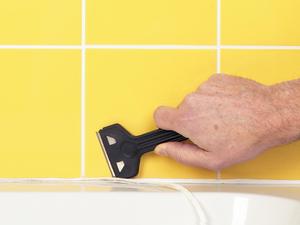
The large silicone pieces are removed first. A lagging piece is picked up with a sharp knife and calmly comes off.
You can use salt to remove the sealant from the tile. Pour salt onto a damp cloth. Wipe dirty areas with light circular motions. In order not to damage the tiles, you do not need to press hard. The polymer will gradually flake off and then fall off.
This will remove all sealant completely. In the same way, the composition is removed from the glass surface. The glass can be heated to speed up the work. The silicone will melt quickly, all that remains is to wipe it off the surface. After the subsequent washing of the glass with any detergent, traces of silicone will disappear forever.
Chemical cleaning
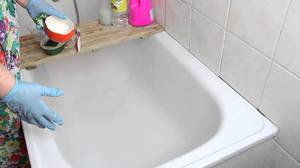 This technology is associated with the use of active drugs. The efficiency of this method is much higher than the mechanical method. However, it is much more expensive. Wash off bath sealant it is possible with special chemical solutions with strict observance of safety precautions. Popular chemicals for removing sealant include:
This technology is associated with the use of active drugs. The efficiency of this method is much higher than the mechanical method. However, it is much more expensive. Wash off bath sealant it is possible with special chemical solutions with strict observance of safety precautions. Popular chemicals for removing sealant include:
- Penta-840.
- Petrol.
- White Spirit;
- Solvent.
A special compound, such as a solvent, is applied to a smooth surface. The loose silicone is carefully removed with a clerical knife
Work must be done very carefully so as not to damage the surface
Freeing the bath from contamination
To get started, you need to prepare a special tool. It will allow you to completely remove the old silicone compound. The list includes:
- Knife.
- Pumice.
- Screwdriver.
- Scissors.
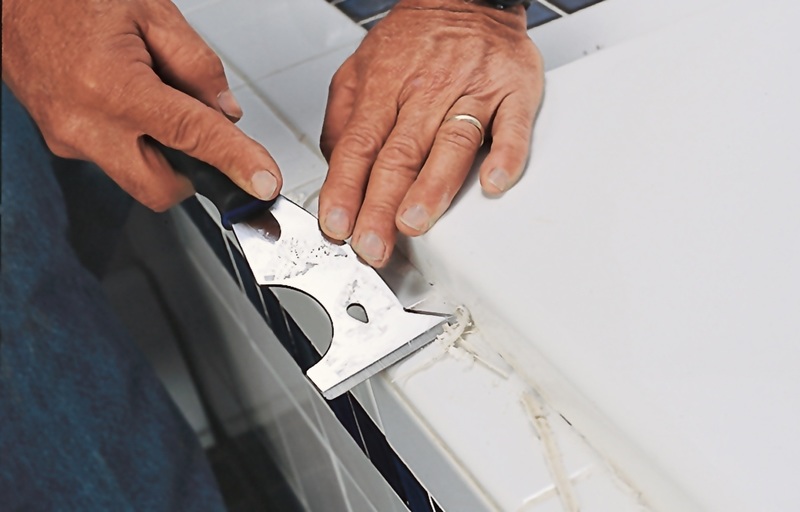
The operation starts from the end of the bath. With a screwdriver, the silicone is torn off around the perimeter of the bathroom. You need to pull it evenly and slowly. Large residues are cut with a sharp knife. Small ones will help remove pumice. Small residues can be soaked in solvent and then simply washed off with water.
The cleaned area is well degreased and a new composition is applied. To prevent the composition from getting into open areas, they must be covered with masking tape. Fresh silicone that has accidentally got into some places can be easily removed with white spirit. If not, you can use vinegar.
Tile cleaning technology
You will need a knife, rag, and solvent to remove. The main part is cut off with a knife. The residues are copiously moistened with solvent. After they become soft, wash them with a damp cloth. In order not to scratch the plastic, you can treat the tiles with a wooden scraper. Silicone will be much more malleable if it is pre-treated with gasoline or any solvent.
How to wash your hands and clothes
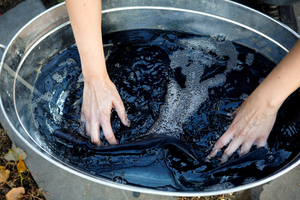 There are several ways to remove sealant from clothing. It all depends on the time it hits the fabric. It is much easier to remove fresh composition.It is necessary to stretch the material, pick up the sealant and quickly remove.
There are several ways to remove sealant from clothing. It all depends on the time it hits the fabric. It is much easier to remove fresh composition.It is necessary to stretch the material, pick up the sealant and quickly remove.
Ordinary vinegar will help deal with dried silicone. The contaminated area is well moistened, wait about five minutes. The residues are then removed with a clean cloth.
You can also use industrial alcohol for removal. The stain is poured with a small amount of solution. Then they take a toothbrush and begin to wipe the wetted area in a circular motion. The glue begins to soften and pellets form. They can be easily brushed off.
To clean your hands, you need to lather them well with laundry soap, then wipe them with a pumice stone. The most effective way to cleanse your hands is to use chemicals.
Cleaning silicone sealant requires special tools and time. But in any case, the result will always be positive.
Removal of used silicone
If it is necessary to remove the sealant due to the loss of its qualities, the following assistants will be needed in the work:
- Stationery knife.
- Safety razor.
- A spatula, you can use metal, wooden or plastic.
- Scrubber sponge.
- Table salt in a bag.
You need to cut the old sealant closer to the wall, but so as not to damage the tiles and the surface to which it still adjoins (countertop, bathroom). After cutting, you can take a strip of silicone and pull it towards you as you cut, so it will be better to see how to cut close to the wall. Further, the residues are removed with abrasives from the proposed list, but very carefully.
Sometimes, after the old sealant on the stove, you can notice a matte coating - it is not difficult to remove it - for this we wash it with wet salt, previously packed in a bag.
 White spirit versus silicone
White spirit versus silicone
Silicone cleaning chemicals
Specialty solvents for cured silicone sealant are available in the form of liquids, aerosols and pastes. The aerosol is shaken before use, the paste is applied with a small spatula, and the swab is moistened with the liquid. As a result of the action of these agents, the silicone softens or turns into an easily washable gruel that can be easily wiped off. But some of these substances can remove not only the sealant, but also damage the base underneath, so the solvent should be tested on a small area before use to make sure it is harmless to the base.

Penta-840 and Dow Corning DS-2025 Solvent Remover for Cured Silicones
You can wipe the sealant off the tile or acrylic bathtub using Dow Corning OS-2 Special Fluid, which is applied to the sealant to soften it, after which the silicone can be easily removed. Dow Corning OS-2 is non-toxic and will not damage the acrylic surface.
Means Penta-840 is also effective in cleaning tiles from silicone, which, after treatment with this composition, is easily separated from the surface, and with longer exposure is destroyed. But you need to take into account that Penta-840 destroys some protective paint and varnish coatings of metals, and make a test application of the substance to the surface to be cleaned.
Removing the sealant from the countertop
The method of removing silicone from countertops is selected depending on the base material. Porcelain stoneware can be cleaned using all existing mechanical, chemical and combined methods. To wipe the silicone off the plastic, use gentle mechanical methods (safety razor, swab with wet salt, brass wire washcloth, detergents) or use chemicals after testing the surface for resistance to the agent used.
Removing silicone from fabrics
Silicone sealant can be removed from natural fabrics with solvents (acetone, white spirit, gasoline, remover varnish). A piece of clean cloth is moistened with liquid, applied to the stain, rubbed in and left for half an hour. To remove the silicone completely, the procedure is carried out several times.
You can also remove the sealant from the fabric mechanically.
To do this, the clothes are straightened, pulled on a flat surface, and then the silicone is carefully scraped off with a metal brush or scraper. This method is applicable to all types of fabrics.
conclusions
In most cases, cleaning from silicone sealant in one way or another gives a positive result. However, this process takes time and money. Therefore, a rational solution to this problem is the preliminary protection of nearby surfaces with a masking tape, which must be removed without waiting for the silicone to harden.
Additional Information: How to wipe off dried silicone sealant from the bath
- If there is a dense layer, using a knife or screwdriver, carefully pry it off and tear it off with a solid strip where possible.
- A suitable solvent is applied to the rest of the sealant and left for several hours or overnight. For neutral, it is best to use alcohol or white spirit, since it is more gentle.
- After the silicone becomes like jelly in consistency, scrape it off with a wooden or plastic spatula.
- We wash the bath with liquid detergent and hot water.
- Wipe with a dry cloth.
If silicone sealant gets on your clothes, the main thing is to start cleaning immediately. It is quite easy to remove fresh silicone from things. You need to stretch the fabric and remove the sealant by picking it up with a hard object. Then you should wash the product in hot water.
The silicone should disappear without a trace.
Today in the construction industry, a substance such as silicone sealant is often used. It is also actively used in everyday life, since it can be used to create a good sealing of cracks or to reliably protect certain surfaces from the effects of an aggressive type of environment. But it often happens that during the repair work, it becomes necessary to remove such a composition that was applied earlier.
And the question arises, how to remove it from this or that surface.
During repair work, safety rules must be observed. How to wipe off dried silicone sealant from the bath? Work with the sealant should only be carried out with protective gloves.
But sometimes it gets on the skin. An attempt should be made to clean it immediately to avoid irritation or an allergic reaction. The following ingredients are required:
At the end of the stripping procedure, it will not hurt to wash the place from which you removed the old sealant with a washcloth and soap solution. True, it is worth remembering that you cannot begin to silicone the same place until the moisture completely dries out, otherwise the substance may simply not stick and all actions will need to be repeated from beginning to end.
To remove the old layer of material, tools such as a screwdriver, sharp knife, pumice stone, scissors are used. With the help of a sharp object, they pick up the material by the edge and tear it off completely. After that, the walls of the booth are removed from the pallet and the remains of the sealant are scraped off with a knife. You can also use a pumice stone for this purpose. It must be handled very carefully, otherwise the booth can be damaged.
If there are still pieces of old material, then they are cleaned with a screwdriver. After the surface of the shower stall has been thoroughly cleaned, it is wiped with a dry and clean cloth.
After that, you need to wash off the remaining yellowish stain. This can be done using dishwashing liquid or glass cleaner. If this does not help, then you will have to use acetone.
In this case, it is important to protect your hands with gloves, and the respiratory system with a respirator
- if the sealant is neutral, wipe the contaminated area with ethyl alcohol. Sometimes alcohol is replaced with nail polish remover, acetone, kerosene, gasoline. It should be borne in mind that these substances burn the skin and provoke allergic reactions;
- if the sealant is acidic, dilute table vinegar with warm water so that a 3% solution is obtained. Wash your hands in it;
- grease your hands with warm vegetable oil, then wipe the stained places thoroughly with baking soda or washing powder;
- wipe your hands with a special tissue to remove the sealant from the skin.
When heated, silicone tends to become soft and elastic. You can use a hair dryer and treat the glass or aluminum surface to remove the sealant. Several chemicals are best suited for home use as a solvent:
Cooking salt. Wrap a spoonful of rock salt in a bandage and soak the bag in warm water. Use the prepared tool to wipe the dirt on the surface.
How to clean a silicone sealant in an aquarium? Then, wash off the greasy silicone with dish detergent or laundry soap. It is recommended to use salt on a surface that is resistant to mechanical damage.

